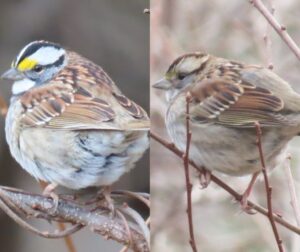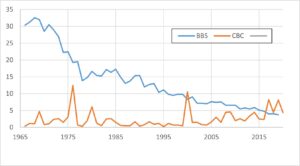(Story and photos by Pam Hunt)
While we tend to think most of the White-throated Sparrow (Zonotrichia albicollis) in association with its distinctive “Old Sam Peabody” song in spring and summer, this species can be found year-round in New Hampshire. During fall migration, its numbers peak in October along with those of other sparrows, giving observers a chance to note a fascinating aspect of this species’ biology.

White-throated Sparrows come in two color morphs, a bright one with bold white stripes on its head (hereafter white-striped) and a dull one where the stripes are tan (tan-striped). These differences are not based on sex, meaning that both males and females can be of either morph. In fact, each morph almost always mates with the opposite one, meaning that you’ll rarely encounter a pair consisting of two white-striped birds. So contrary to popular perception, white-striped birds are not necessarily males and tan-striped ones females.
These morphs result from a gene change in a single chromosome pair and are correlated with consistent behavioral differences. White-striped birds are more aggressive, sing more (including the females), and exhibit less parental care (particularly the males) than tan-striped birds. Mixed pairs are probably favored evolutionarily since two white-striped sparrows would provide less care to their young, while two tan birds would not do as well in defending their territory. If you have White-throated Sparrows at your feeders in the winter, you can observe interactions between the two morphs – chances are you’ll see the brighter birds chasing off the duller ones more than the other way around.
White-throated Sparrows are one of the most abundant breeding birds in New Hampshire’s northern and higher elevation conifer and mixed forest, but only occur in scattered locations (often bogs) south and east of Concord. In winter, however, this pattern is reversed, and white-throats are concentrated in the southeast and the major river valleys. But while still common across its extensive breeding range (New England to western Canada), this species is in long-term decline in New Hampshire (Figure 1, BBS) and the Northeast in general. The reasons for this decline are not well understood, but could include loss of shrubby edge habitat to forest succession. It is also a frequent victim of window collisions during migration, and studies have demonstrated lowered physiological performance after prolonged exposure to pesticides.

At the same time, winter data for New Hampshire show a slight and very gradual increase (Figure 1, CBC). This may reflect the influence of bird feeders, gradually moderating climate, or a combination of both. Winter data from farther south show the same declines as the breeding data, albeit not as dramatic, so the increases in New Hampshire almost certainly reflect a slight northward shift of the non-breeding range. The high variation in the winter data is probably due to multiple factors. One might be the severity of the winter, with more birds continuing south when there is more snow and/or colder temperatures. Birds such as sparrows also respond to available food supplies, moving farther south if local food is scarce. At the same time, high natural food crops can also result in fewer birds visiting feeders for people to observe, so be sure to keep this in mind if you notice an absence of birds in your yard.
State of the Birds at a Glance:
- Habitat: Forests
- Migration: Short-distance
- Population trend: Strongly declining
- Threats: Habitat alteration, collisions, pesticides
- Conservation actions: Avoid harmful pesticides, minimize window strikes, keep cats indoors
